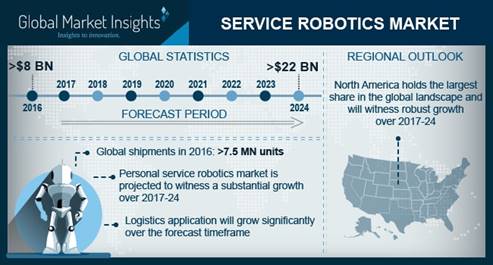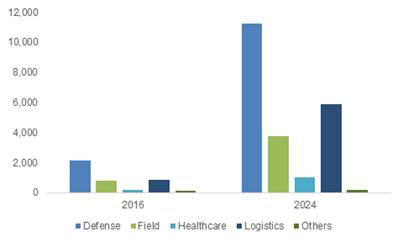Service robotics market revenue will hit US$22bn by 2024, GMI report claims

As per a recent industry report put forward by Global Market insights Inc. , service robotics market is forecast to register its name in the billion-dollar fraternity down the line of six years, by exceeding a revenue of US$22 billion (€19 billion) by 2024.
The service robotics market is projected to reach a revenue of more than $20 billion (€17 billion) in 2024. These systems are anticipated to witness a high growth during the forecast time span owing to their high convenience, reliability, and the efficiency as compared to the conventional labour solutions. The rising proliferation of IoT and the integration of AI are aiding in the transformation of the service robotics market.

These systems reduce the number of faults and errors and provide accurate and high-quality services. The cost of labour is increasing at a very drastic rate. For instance, hourly labour costs in the Euro area (EU28) witnessed a 2.2% yearly growth until 2016. The increase in labour costs is increasing the overall costs of the goods and services that are produced. Additionally, these can reduce an organisation’s profits and cause them to incur higher financial costs such as payroll taxes, increments, and hiring subsidies.
The adoption of the service robotics market is highly beneficial in the reduction of human casualties suffered during activities, primarily in defence and certain research activities such as underwater cave discoveries. In recent years, internal and external security threats have compelled governments of various organisations to adopt these solutions and are substantially contributing to the strong growth of the service robotics market. These systems can be used in conducting discrete surveillance activities or for implementing activities that are highly dangerous to human personnel.
The personal product segment of the service robotics market is predicted to dominate in terms of revenue during the forecast timeframe. Personal robots, such as vacuum cleaners, automated wheelchairs, and domestic servants, among others have aided in improving the quality of life and providing an increased convenience to their users. For instance, in homes with geriatric inhabitants, who live alone, these robots are ideally suited for monitoring and diagnosing patients by relaying the information back to the medical practitioners or alerting authorities during emergencies such as when the patient falls from a wheelchair.

China Professional Service Robotics Market Share, By Application, 2016 (Units)
The professional application segment of the service robotics market is anticipated to witness a high growth owing to the increasing adoption of these systems for carrying out mundane and monotonous tasks such as milking, packing, and other activities. Medical robot systems are finding increasing applications in providing assistance during surgeries, therapy, and patient caring, contributing to the heavy growth of the service robotics market. For instance, Robot Aps has developed and launched a rehabilitation robot to assist health professionals with patients, who are bed-ridden, reducing the dependence on nurses for actions such as heavy lifting.
The increase in manufacturing and industrial activities, primarily in the South-East Asian and Latin American regions, contributes to the strong growth of the service robotics market. For instance, warehousing robots are deployed in factory spaces to reduce monotonous activities such as shelving and packing and increasing the output as compared to the manual labor. Additionally, the Asia Pacific region is also incorporating these systems as a part of its education and teaching sector. Pre-schools in Singapore, for instance, have implemented humanoid robots on a testing basis to deliver high-quality education to students.
The service robotics market players comprise Bluefin Robotics, BAE Systems, AeroVironment, Inc., OMRON Adept Technologies, Inc., 3D Robotics, iRobot Corporation, Medtronic, Delaval International AB, ECA Group, Geckosystems Intl. Corp., and Intuitive Surgical, Inc. Companies are required to continuously invest in business strategies, such as R&D, partnership, mergers, and acquisitions, to sustain growth in the global service robotics market. For instance, in May 2016, Medtronic entered into a partnership agreement with Mazor for the development of surgery robots and the launch of its internally-developed robotic surgery program.
Comment on this article below or via Twitter @IoTGN
